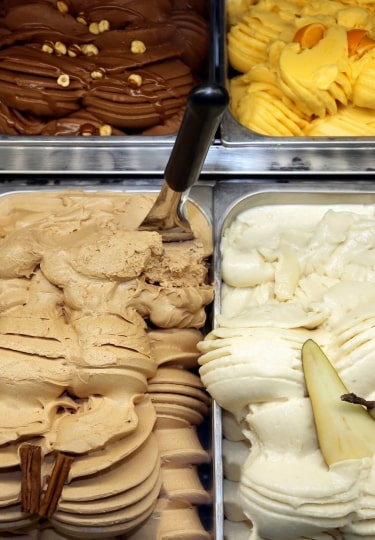“Pizza and pasta” might be the first timer’s knee-jerk response to the prospect of what to eat in Rome. However, as you might expect with a city this ancient and a food culture this inventive, other options are available (although never fear, there is enough pizza and pasta to fill St. Peter’s Basilica).
As anyone who has visited other cities in Italy discovers—Venice, Palermo, or Naples—each city and region creates its own distinctive take on Italian cuisine. The Eternal City is the same, with its quartet of beloved pasta dishes such as “cacio e pepe” and “rigatoni carbonara” brought to life by shavings of sharp pecorino romano, the local answer to Parmigiano Reggiano.
Then there’s cuisine as much the product of social forces as cheffing instinct, such as those deeply satisfying winter dishes that use cuts of meat categorized as the Quinto Quarto. What to eat in Rome is a prospect as multi-layered and artful as the Sistine Chapel, and just as fulfilling.
Pizza al Taglio
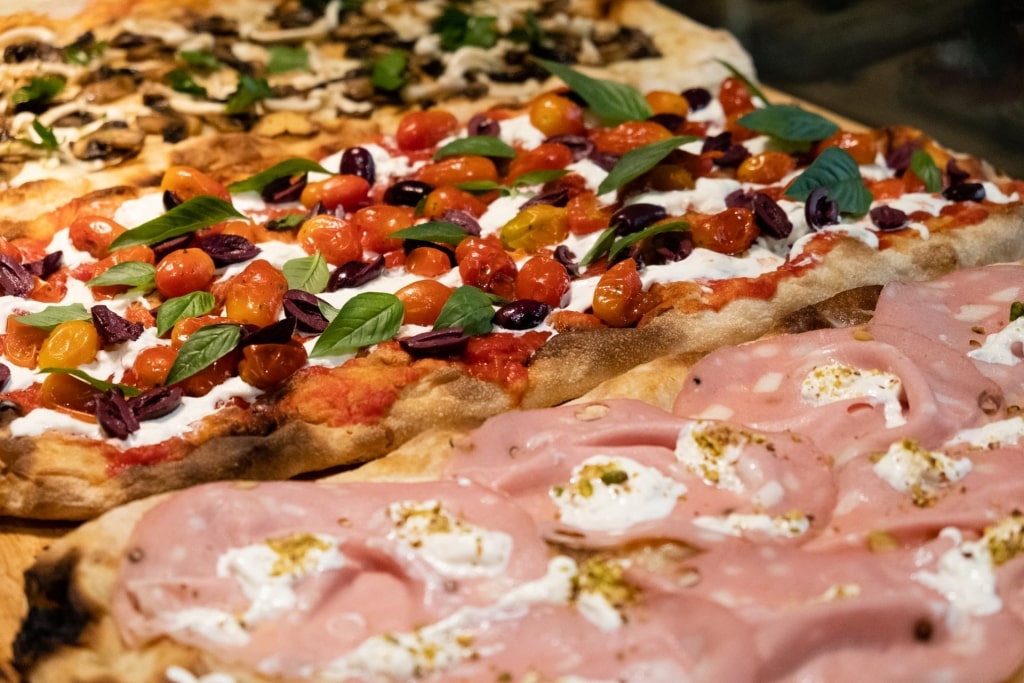
Pizza al Taglio
A style of street food that has galloped around the globe, pizza al taglio translates as “pizza by the slice”. Invented in Rome, the original pizza by the slice comes cut from large rectangles of crispy, saucy, cheesy, liberally-topped pizzas. The round format that you might be more familiar with, or “pizza tonda”, hails from Naples to the south.
Invented in Rome in the late 1950s, pizza al taglio’s pioneering pie was, according to record, simply dressed with tomato sauce and olive oil. Today in the city of the Caesars you’ll find a legion of toppings available. Truffle, eggplant, even potato – but don’t expect to find pineapple.
While decent pizza al taglio can be found throughout the historic center and beyond if you’re hungry and near the Vatican Museums, pop into Pizzarium. This tiny spot with a huge reputation delivers dozens of pizzas daily to its discerning clientele. Pair your slice with one of Pizzarium’s Champagne miniatures. Expect a wait at peak times.
Read: Best Pizza in the World
Pizza Romana
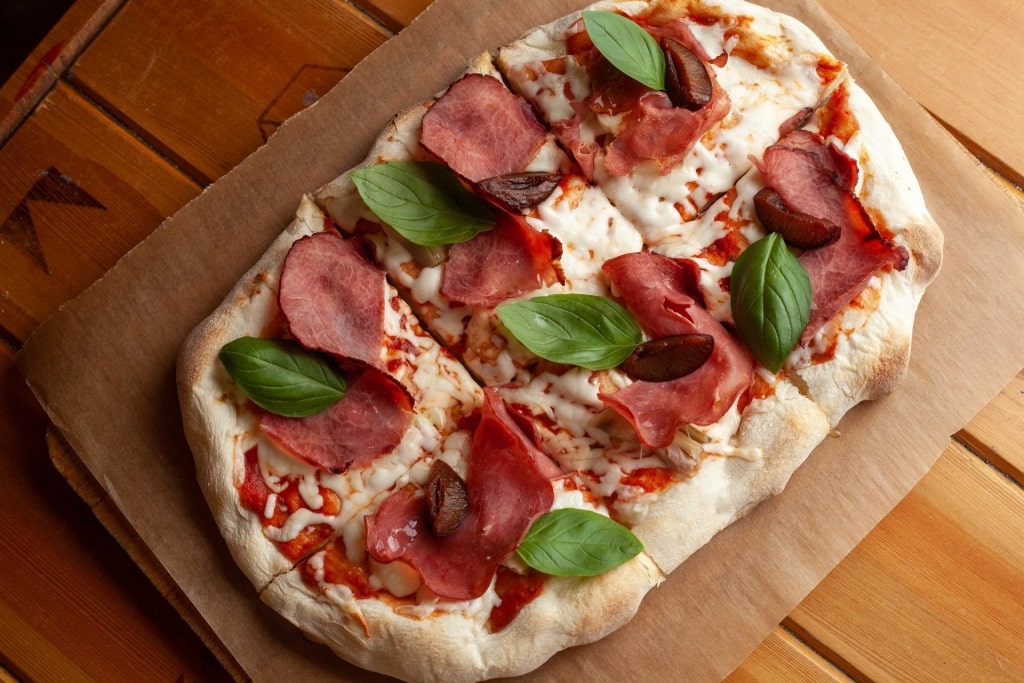
Pizza Romana
The quintessential Roman pizza, thin-crust Pizza Romana has slowly begun to gain traction throughout the rest of the peninsula and abroad. It’s what to eat in Rome to truly understand the city’s pizza culture.
This impressively thin, cracker-crisp pizza (also known as scrocchiarella or “the crunchy one”) comes with toppings perilously near the pizza’s edge. This is made possible as Pizza Romana comes without any crust, another nefarious invention of Napoli.
Often available by the slice, Pizza Romana retains its shape well for eating on the go. It’s a perfect choice to chew thoughtfully while circumnavigating the stone reliefs on the Column of Marcus Aurelius in Piazza Colonna.
To emphasize the difference between the two pizza styles, you’ll find the Neapolitan style described as “pizza alta” to Romana’s “pizza bassa” (high and low). Hunt down centrally-located pizzeria Emma for an epic Pizza Romana experience, where a brother and sister team has raised this style to new heights of sophistication.
Rigatoni Carbonara
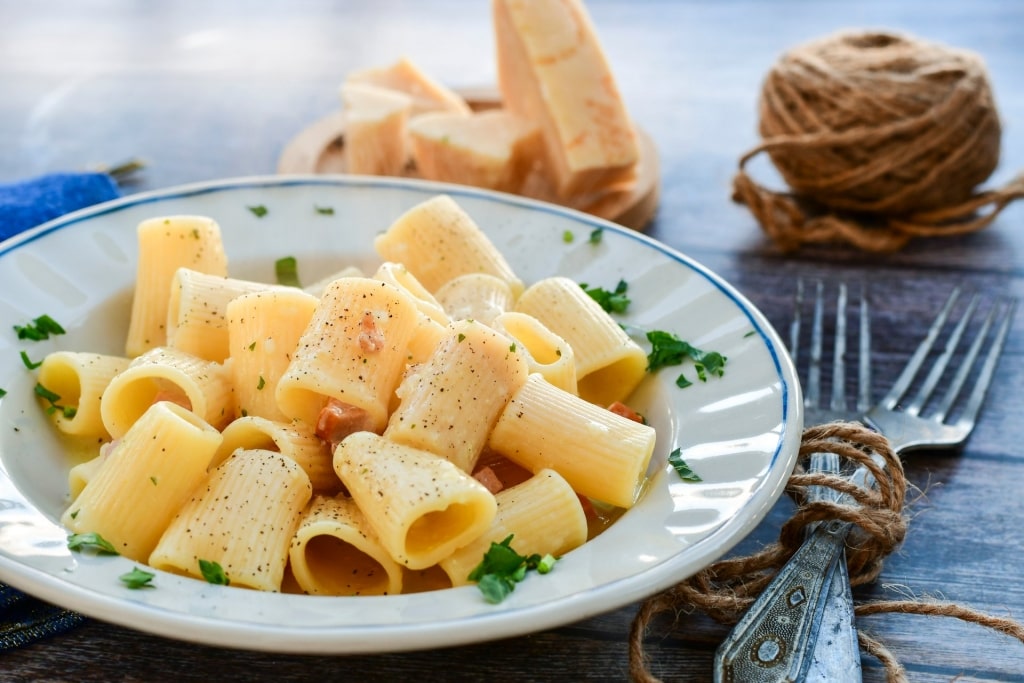
Rigatoni Carbonara
One of Rome’s iconic dishes, carbonara is one of those Italian recipes over which passions run high.
Hailed as one of the Italian capital’s quartet of classic pasta dishes—alongside amatriciana, gricia, and cacio e pepe—carbonara is perhaps the most widely wronged of this famous foursome. It’s all a matter of interpretation. Outside of Italy, carbonara, as viewed by Italians, is too often a quagmire of cream into which is drowned fatty pieces of substandard bacon.
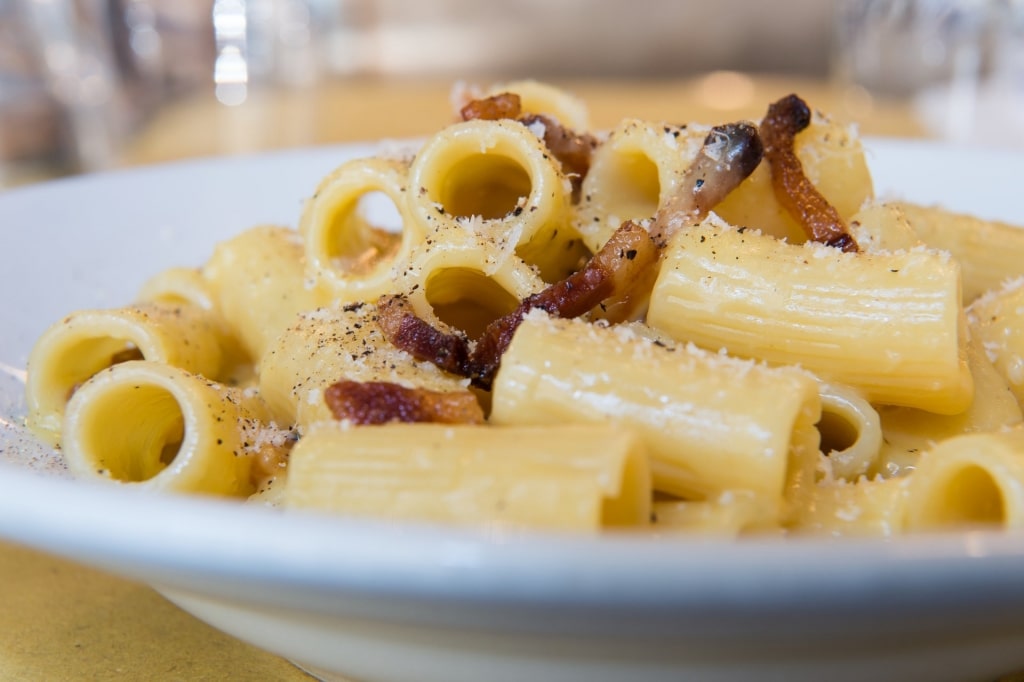
Rigatoni Carbonara
True carbonara is all about a light touch. Its noodles glisten with an egg sauce imbued with sharp pecorino, aromatic black pepper, and flavorful pieces of cured pork jowl called “guanciale”. This latter ingredient can be difficult to procure outside of the Italian peninsula, so cubed pancetta offers an acceptable stand-in.
Which pasta is the most suitable for the sauce is a debate as eternal as Rome. Like the Guelphs and Ghibellines of Italian history, those that prefer spaghetti insist on it, while others are staunchly loyal to rigatoni. The latter’s long tubes become well coated in the sauce, and their mouthfeel lends itself to the airy nature of a true carbonara.
Gelato

Gelato
Any list of what to eat in Rome has to include gelato. A cone-full of Italian summer color, its vivid flavors, and heat-beating qualities vie with pizza al taglio as the perfect perambulating picnic while contemplating the arcaded stories of the Colosseum.
So why gelato and how does it differ from its culinary cousin, ice cream? This frozen dessert is churned more slowly than ice cream, a technique that produces a denser texture. It’s also made with about two-thirds the amount of butterfat. The takeaway? When in Rome, add another scoop.

Gelato
Gelato is not Roman-born. At least, that’s the popular belief. Its origins reach back into the late Renaissance, although there is some uncertainty over its inventor. However, it is widely accepted that Florentine Bernardo Buontalenti debuted the treat at the court of Catherine de Medici.
Of course, this being Rome, they’ll tell you that their gelato is the best. And they might be right. Put their convictions to the test at Neve di Latte near Piazza del Popolo for the full scoop.
Cacio e Pepe
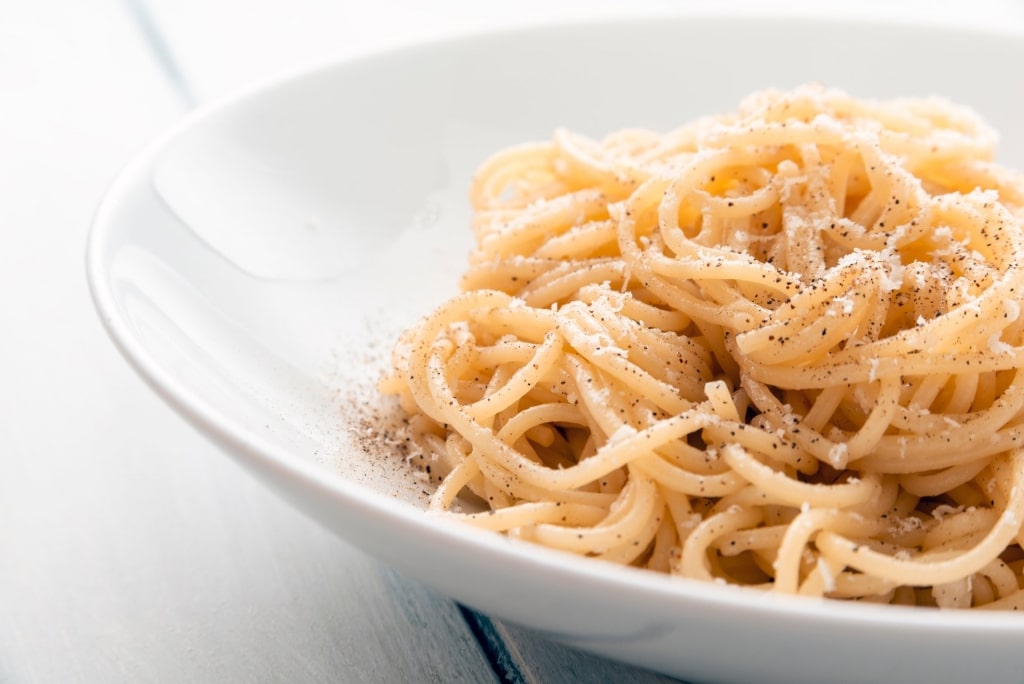
Cacio e Pepe
One of the city’s most beloved and widespread dishes, cacio e pepe is interpreted by some as a “minimalist mac n’ cheese”. The dish advertises its short ingredient list with its name, which translates as “cheese and pepper”. Of course, there’s also pasta and a splash of the starchy water in which the pasta is cooked to deliver the sauce’s silken quality.
Such a simple and delicious dish has suitably ancient origins, with its recipe dating back to the cookbooks of the Roman Empire. It’s also known as the dish of the shepherds, as their easy access to sheep’s milk cheese makes a quick, filling bowl of cacio e pepe simple to prepare.
Supplì

Supplì
Fried rice balls similar to the Sicilian dish of arancini, supplì are about half the size of their island cousins.
And whereas teardrop-shaped arancini blend minced beef and peas into the mix, the oblong supplì are typically a heavenly duo of arborio rice (the kind used in risotto) cooked in a tomato sauce encasing a gooey mozzarella heart. However, for the diehard traditionalists, there is a version that includes chicken giblets should that tickle your fancy.

Supplì al telefono
A citywide treat that’s typically available to buy in any bakery in Rome, supplì are also perennially popular antipasti to order when you’re out for pizza. The dish’s full name is supplì al telefono—a reference to that immensely appetizing string of mozzarella that connects the two halves after you’ve broken it open.
Porchetta
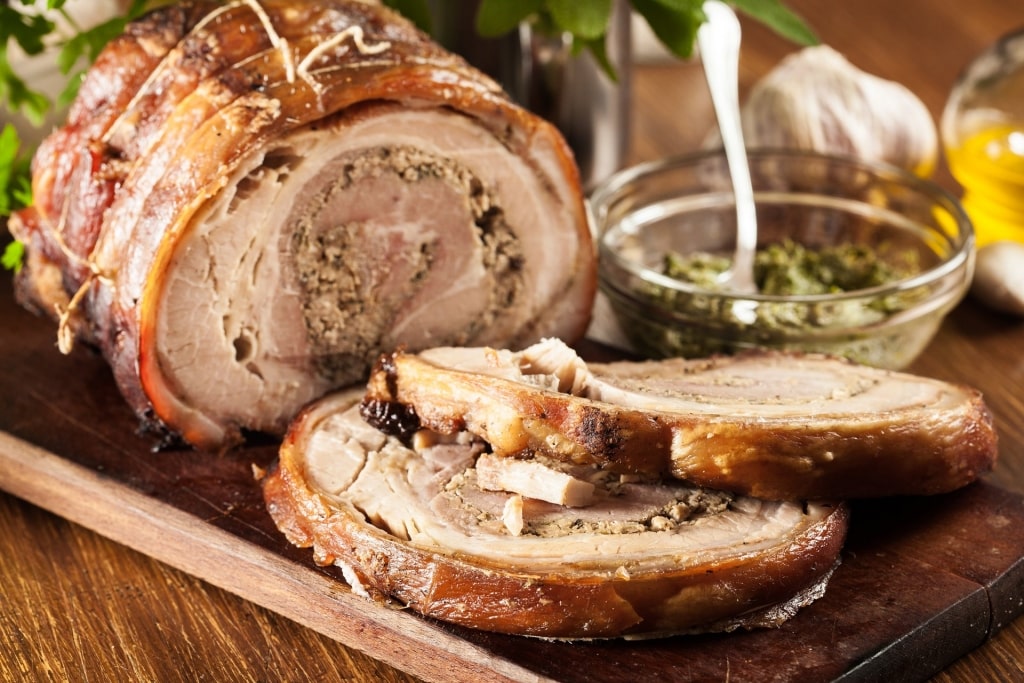
Porchetta
A specialty that belongs to the central region of Lazio in which Rome is situated, porchetta is a slow-roasted, well-seasoned, crisped-up hunk of pork. It’s what to eat in Rome if you’re a carnivore.
Rome may be the capital of Italy, but the Castelli Romani area, south-east of the capital, is the capital of porchetta. If you’re visiting Rome in September, there’s a pork fest in the town of Ariccia that, if you have time, will give you memories to salivate over for years to come.
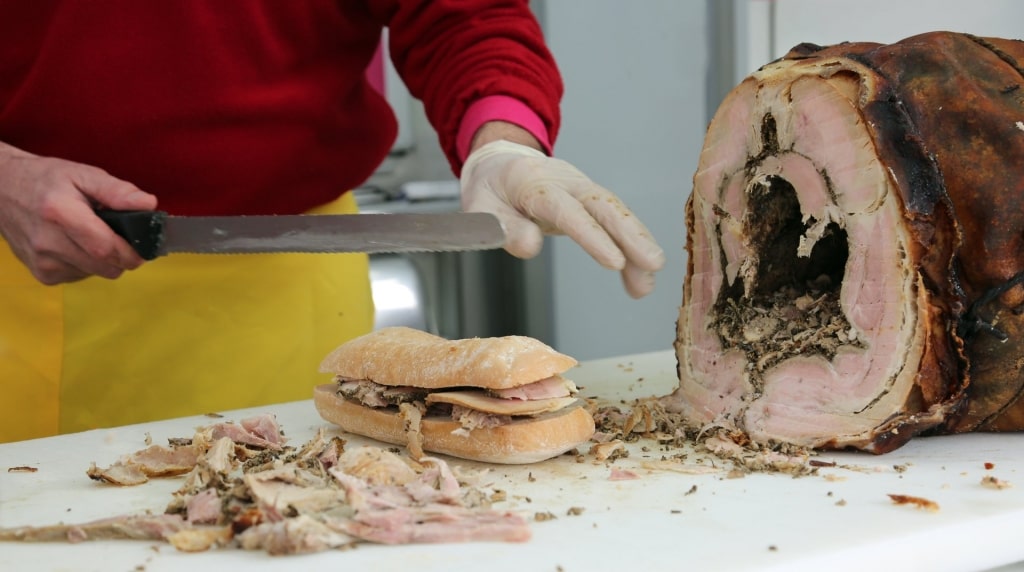
Porchetta
What differentiates porchetta from other pork roasts is how the fennel, rosemary, and garlic aromatize the moist flesh. While it’s a pleasing thought to imagine it served in all its grandeur at a table for one, porchetta is commonly sliced up into fillings for multiple mouthwatering paninis or as toppings for pizza bianca (a pizza served without tomato sauce).
While Castelli Romani may be a little too far-flung for your visit, you can have your own pork fest at the highly regarded porchetta purveyors, the Norcineria Lacozzilli deli. You’ll find it in Rome’s trendy neighborhood, Trastevere, across the elegant Ponte Sisto bridge from the historic center.
Maritozzi

Maritozzi
Maritozzi are maybe the only items on this list of what to eat in Rome that will turn your head from gelato. Best of all, a maritozzo—a sweet brioche bun with a central reservoir overflowing with velvety whipped cream—is intended as breakfast.
A Lent treat, maritozzi (the plural of “maritozzo”’) are sold throughout Rome’s forni (bakeries) along with medieval quaresimali almond biscuits. The maritozzi brioche, fragrant with lemon zest, often comes studded with sultanas, candied peel, or that Italian favorite, pine nuts.
Beware, however, of casually offering someone a spare maritozzo on March 1. Since the 19th century, the offer of a maritozzo has signified an imminent proposal of marriage, often with the engagement ring nestled within the cream.
If you’ve less of a sweet tooth, there are also savory maritozzi available with tomato sauce and ricotta in place of the cream.
Artichokes
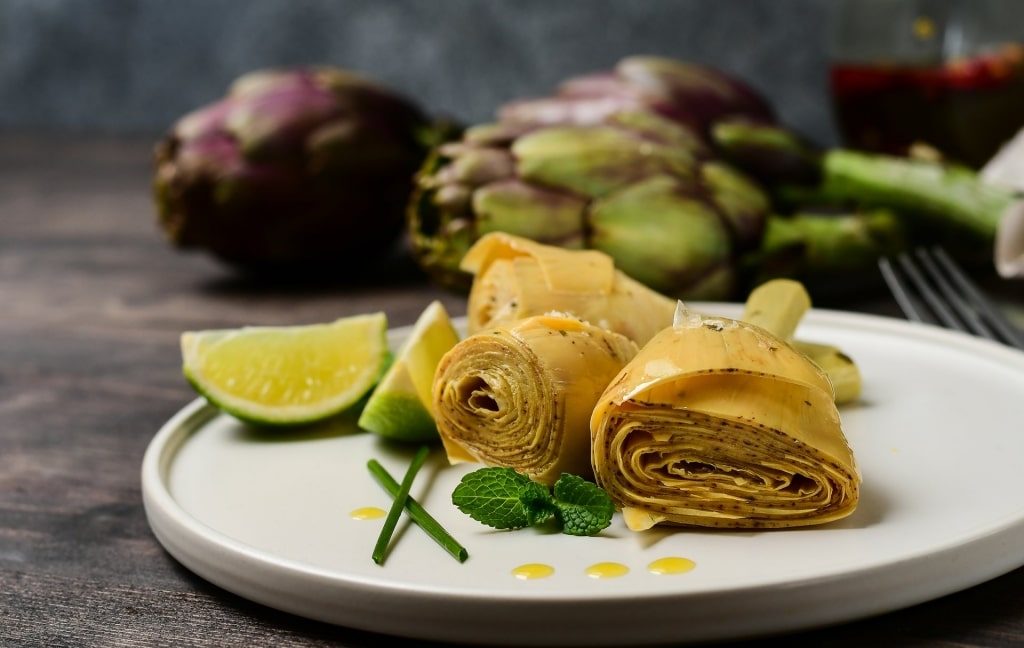
Artichokes
In the eyes of Romans, not all artichokes are equal. The Carciofo Romanesco variety is Rome’s beloved artichoke—a baseball-sized flower that differs from other artichokes with its softer leaves and absence of tickling inner bristles above the heart.
Artichokes are what to eat in Rome between February and May, when they’re in season. You’ll see their violet-tinted rotundas piled up across the city’s produce stalls.
Carciofo romanesco is generally prepared in one of two ways in Rome. “Carciofi alla Romana” is an ancient dish involving stuffing the artichokes with a mix of garlic, parsley, and wild mint. These are then slowly braised until the fresh, fulsome flavor of the herbs has spread throughout the flower.
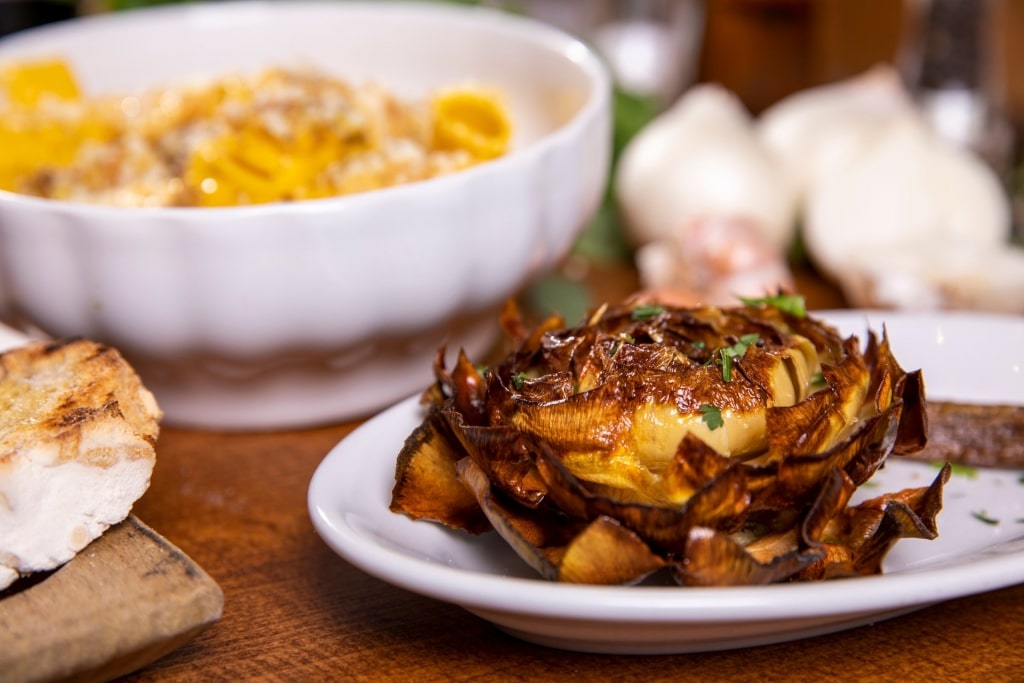
Carciofi alla Giudia
The alternative preparation, that emerged from the former Jewish ghetto near Venice Square, is “Carciofi alla Giudia” or artichokes Jewish-style. This 16th-century recipe sees the artichokes well seasoned before being fried twice in oil.
The resulting gloriously golden, frazzled flower is eaten whole. The leaves have a potato chip consistency, while the interior is buttery and lip-smackingly delicious.
Saltimbocca Alla Romana
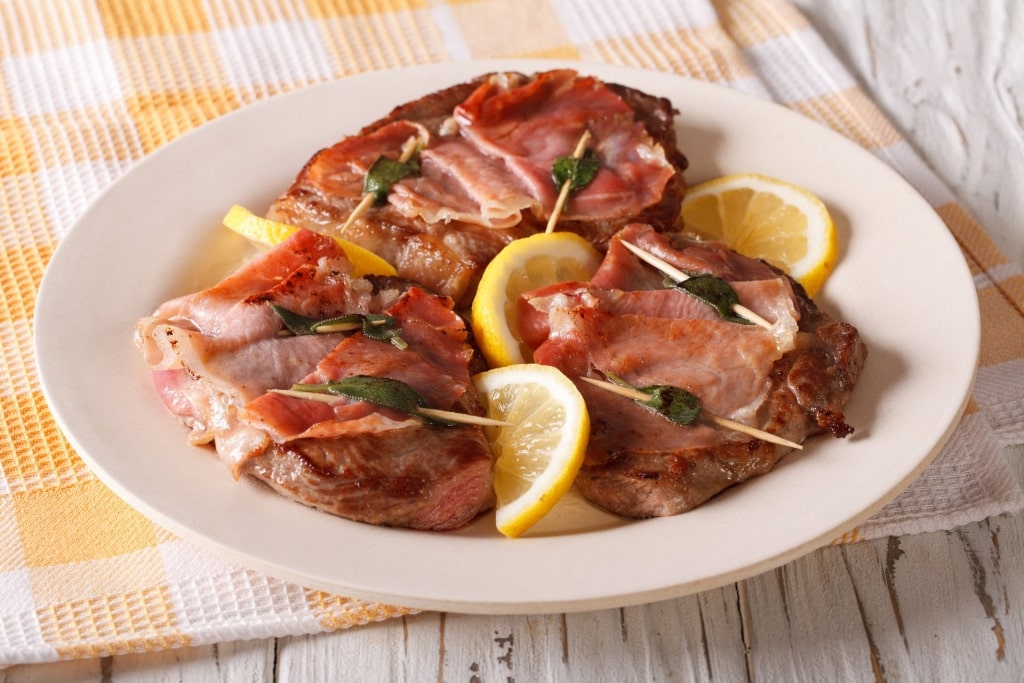
Saltimbocca Alla Romana
Reportedly Brescian in origin, the dish of Saltimbocca alla Romana translates as “jumps in the mouth”. The original recipe is a medallion of veal parcelled up in a wrap of prosciutto and sage before being fried in butter and sweet marsala.
Variations on the ingredients do occur, with chicken or pork substituted in for the veal. The cut of meat is then pounded flat like Wienerschnitzel. Brescian or Roman? Who cares, it’s delicious. Try it at Trattoria da Teo or Armando al Pantheon for some of the city’s best efforts.
Trippa Alla Romana
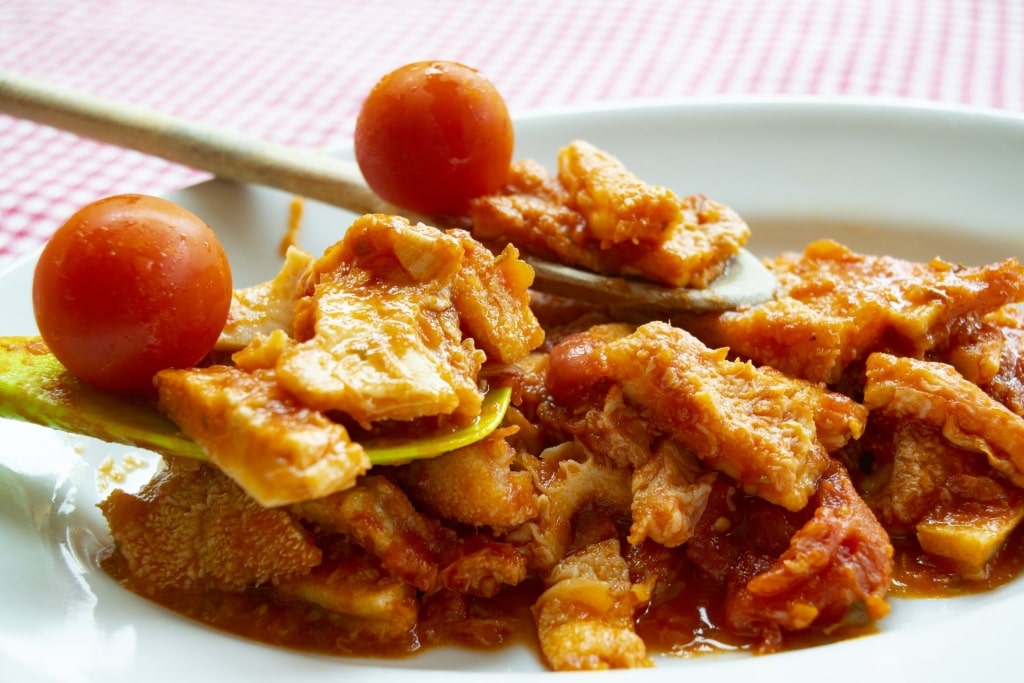
Trippa Alla Romana
Perhaps lacking the universal appeal of Pizza Romana, Trippa alla Romana (Roman tripe) is nevertheless what to eat when in Rome.
The dish is emblematic of an intriguing element of Rome’s culinary history. Cuts such as this one made from the cow’s stomach were known as the “Quinto Quarto”, or “fifth fourth”. This category encompassed all the leftovers from an animal available to the lower classes of Rome, while the higher classes absconded with the better cuts.
While the classification was finally discarded in the early 20th century, today Trippa alla Romana persists as one of the city’s winter comfort foods. It’s a staple on the trattoria menus of the formerly working-class Testaccio district. As with that other working-class classic, cacio e pepe, the ingredients are minimal.
The tripe is slowly braised in a tomato sauce until it’s soft and chewy, before being served showered with pecorino romano and shreds of wild mint. A side of crunchy bread offers a more-ish contrast with the yielding consistency of the tripe.
Coda Alla Vaccinara
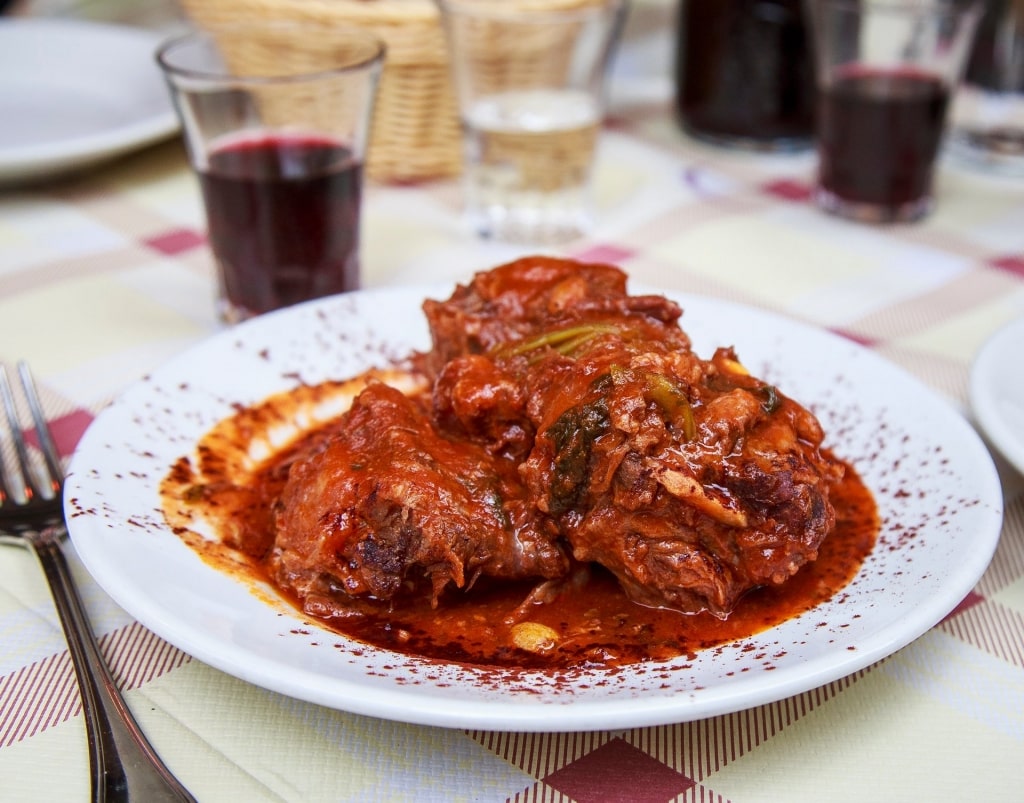
Coda Alla Vaccinara
Coda alla vaccinara is umami, stick-to-your-ribs cold-weather cuisine beloved by the Romans.
Another Quinto Quarto classic, coda alla vaccinara (translating as “ox-tail stew”) is a specialty that hails from Rome’s riverside Rione Regola area. The locals in what is today a charming, cobblestoned neighborhood were nicknamed “tail-eaters”, indicating how frequently this dish was eaten.
The modern version of the dish includes wine, chopped pancetta, and a dash of cocoa powder amid a mix of herbs. It’s often paired with creamy polenta that soaks up the rich, running juices.
Cicoria Ripassata
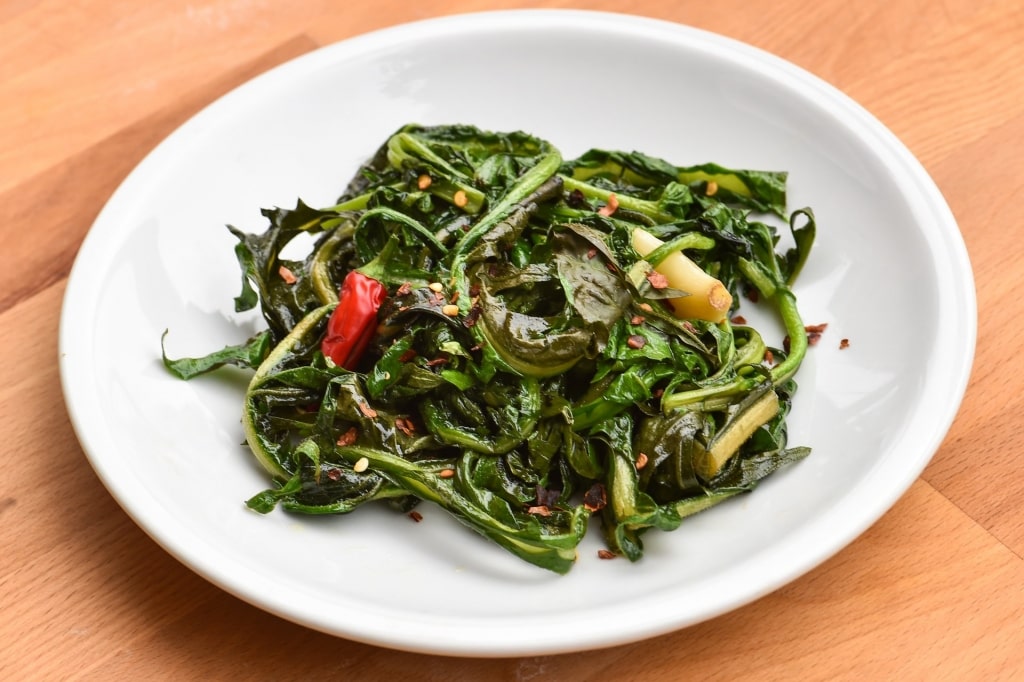
Cicoria Ripassata
After all that meat, it may come as a relief to find some vegetables rounding off this list of what to eat in Rome. Cicoria ripassata is a traditional green contorno, or side, made from chicory’s bitter leaves.
A relative of the dandelion, the Italian diaspora in the United States have been known, when chicory was scarce, to substitute dandelion leaves into their cicoria ripassata. It’s a practice in keeping with the cucina povera origins of this dish when the Italian working class had to harvest what were the weeds of Rome to survive.
In the “alla Romana” version, the chicory is first boiled before being sauteed in chili and garlic. Another version of this dish is cicoria all’agro which involves boiling the leaves before topping them with lemon and olive oil. But when in Rome…
Read: How to Spend 3 Unforgettable Days in Rome
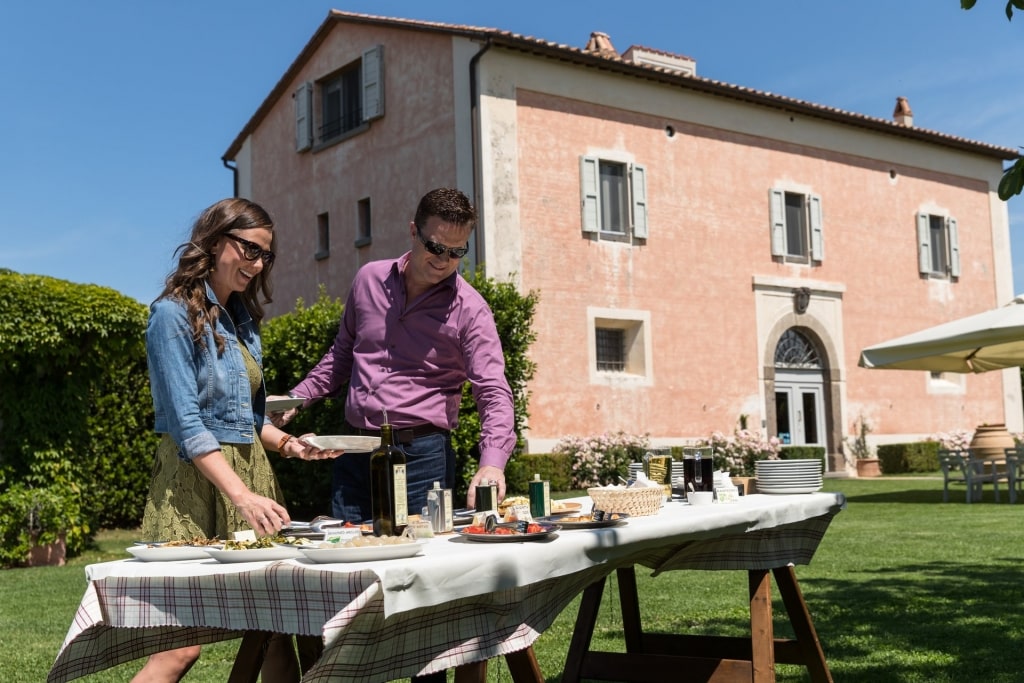
Rome
Explore Rome’s diverse and delicious culinary heritage—not to mention its countless pizzerias—on a cruise to Rome. Browse cruise itineraries on our website and book a vacation to this stunning country today.
